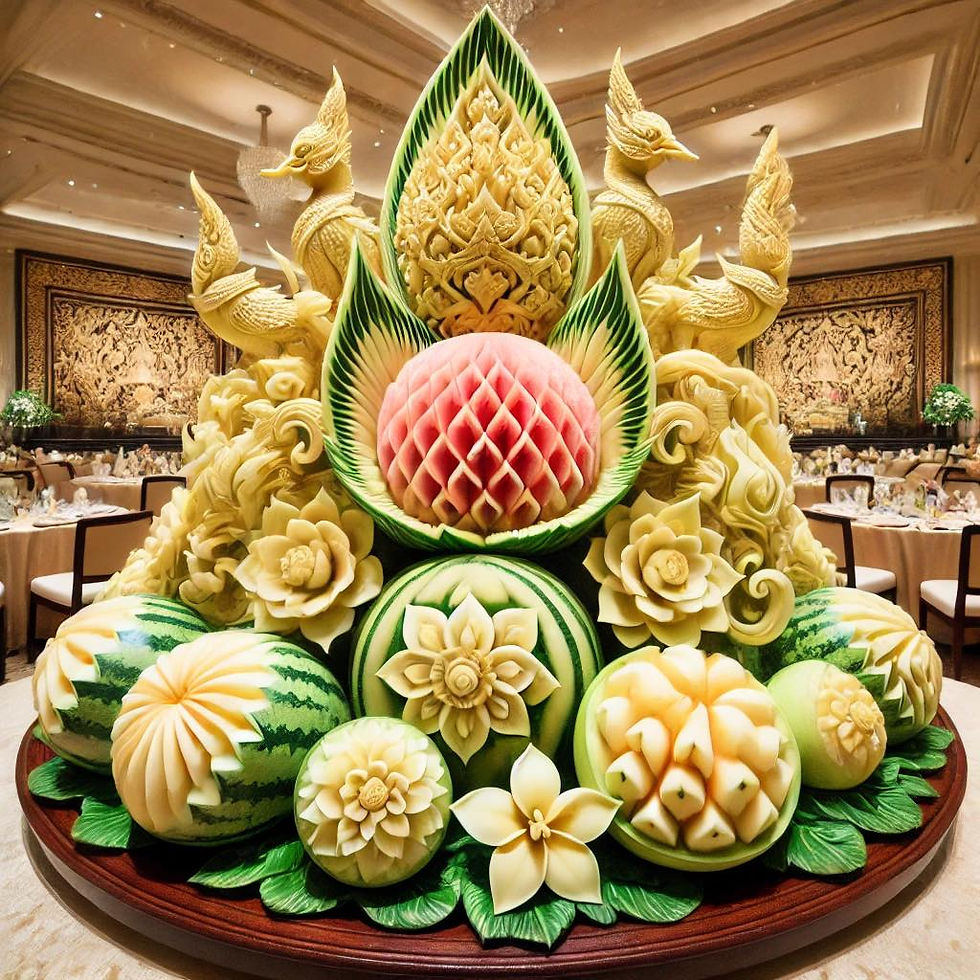The Art of Thai Fruit Carving: From Royal Courts to Modern Tables
- THE SHARPENER
- Feb 24
- 4 min read
In the vibrant tapestry of Thai culture, few art forms capture the essence of beauty, creativity, and culinary tradition quite like the art of Thai fruit and vegetable carving. For expats living in Thailand, understanding and appreciating this unique cultural practice offers a window into the heart of Thai aesthetics and hospitality. The art of fruit and vegetable carving, known in Thai as "Kae Sa Luk," is not merely a decorative technique but a cherished cultural heritage that has evolved from the royal courts to become an integral part of modern Thai culinary presentation.

This intricate art form represents more than just a way to make food visually appealing; it embodies the Thai values of patience, attention to detail, and the harmonious blending of nature with human creativity. For expats, delving into the world of Thai fruit carving can provide profound insights into Thai culture, enhance their appreciation for local customs, and even offer a unique way to engage with their Thai hosts and colleagues.
Historical Significance
The origins of Thai fruit and vegetable carving can be traced back to the royal courts of the Sukhothai Kingdom (1238-1438). Legend has it that during the Loy Kratong festival, a court lady created elaborate carvings to decorate her kratong (floating basket), impressing the king and establishing a tradition that would be passed down through generations.
Over the centuries, this art form evolved from a courtly practice to a wider cultural phenomenon, becoming an essential element in important ceremonies, religious offerings, and high-society gatherings. Today, it remains a symbol of Thai cultural refinement and hospitality, often showcased in upscale restaurants, hotels, and during significant events.
Cultural Importance
Thai fruit and vegetable carving is considered a cultural wisdom that requires concentration, meticulousness, creativity, and extensive practice]. It represents Thai identity and adds value to Thai cuisine, elevating simple ingredients into works of art. For expats, understanding this aspect of Thai culture can greatly enhance their appreciation of Thai hospitality and attention to detail in everyday life.
The Art Form
Techniques and Tools

Thai fruit carving involves various techniques, including:
Bas-relief carving: Creating intricate patterns on the surface of fruits and vegetables.
Three-dimensional carving: Transforming whole fruits into elaborate shapes and figures.
Assemblage: Combining multiple carved elements to create complex designs.
The tools used are typically simple yet precise, including a series of specially designed knives with different blade shapes and sizes.
Common Motifs and Designs
Traditional Thai fruit carving often features:
Floral patterns, especially the lotus flower
Animals, particularly birds and mythical creatures
Geometric designs
Scenes from nature or Thai folklore
Modern Applications
While rooted in tradition, Thai fruit carving has found its place in modern contexts:

Hospitality Industry: Hotels and restaurants use fruit carvings to enhance the dining experience and showcase Thai culture to international guests.
Event Decoration: Carved fruits and vegetables are popular in weddings, corporate events, and cultural festivals.
Culinary Education: Many culinary schools in Thailand and abroad now offer courses in Thai fruit carving.
Cultural Diplomacy: Thai fruit carving demonstrations are often featured in international cultural events to promote Thai heritage.
Appreciation and Etiquette for Expats
For expats living in Thailand, here are some tips to appreciate and engage with this art form:
Observe with Respect: If you encounter fruit carvings at events or in restaurants, take a moment to appreciate the skill and time invested in creating them.
Learn the Basics: Consider taking a short course in fruit carving. Many hotels and cooking schools offer classes for beginners.
Appropriate Photography: Always ask permission before photographing fruit carvings, especially in formal settings.
Engage in Conversation: Showing interest in fruit carving can be a great way to connect with Thai colleagues or hosts.
Challenges and Preservation
One of the unique challenges of Thai fruit carving is its ephemeral nature. Unlike other forms of art, these masterpieces are not meant to last, making the preservation of this cultural heritage particularly challenging. Efforts to preserve this art form focus on:
Documentation through photography and video
Teaching and passing down skills to younger generations
Promoting fruit carving as a valuable cultural asset

For expats in Thailand, the art of Thai fruit carving offers a unique lens through which to view and appreciate Thai culture. It embodies the Thai appreciation for beauty, detail, and the harmonious blending of nature with human artistry. By understanding and respecting this cultural practice, expats can deepen their connection to Thai society and gain valuable insights into the values that underpin Thai hospitality and aesthetics.
Whether you're admiring a carved watermelon at a hotel buffet or watching a master carver at work during a cultural demonstration, remember that you're witnessing a living tradition that has been passed down through generations. This art form, while visually stunning, represents much more than mere decoration; it's a tangible expression of Thai cultural identity, creativity, and the pursuit of beauty in everyday life.
By engaging with and appreciating the art of Thai fruit carving, expats can enhance their cultural experience in Thailand, fostering deeper connections with their Thai hosts and gaining a richer understanding of the nuanced ways in which Thai culture celebrates beauty, skill, and tradition.
.png)


Comments